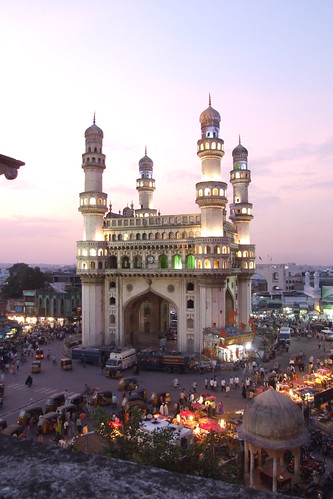Charminar, meaning "Four Towers" or "Mosque of the four minarets", is one of the most important monuments in the city of Hyderabad, the capital of the Indian state of Andhra Pradesh. The area surrounding Charminar is also known by same name. There is a market around Charminar. The Charminar looks particularly spectacular at night when it is illuminated.
According to history, Muhammad Quli Qutb Shah built the monument in 1591, shortly after he had shifted his capital from Golkonda to Hyderabad. As per legends, the building was built to honor a promise Quli Qutb Shah made to Allah. He had prayed for the end of a devastating plague and vowed to Allah that he would build a mosque there.
There are also legends that in 1591 while laying the foundation of Charminar, Quli prayed, “Oh God, bestow unto this city peace and prosperity. Let millions of men of all castes, creeds and religions make it their abode, like fishes in the water”. The mosque became popularly known as Charminar. The four minarets were possibly to honor the first four caliphs of Islam. The actual mosque is at the top floor of the four-story structure.
The Charminar is a square monument. Each side measures 20 meters, and each of the corners has a tall, pointed minaret, soaring to a height of 48.7 m (159.77 ft) from the ground. Unlike the Taj Mahal, Charminar's four minarets are built into the main structure. In each minaret 149 winding steps take the visitors to the top floor that provides a panoramic view of the city of Hyderabad and the surrounding areas.
Each arch of the Charminar is 11 m wide and rises 20 m from the plinth, which is like a large table 7-8 feet above the ground with steps to go up. The four arches have clocks that were installed in 1889. A vault that appears from inside like a dome, supports two galleries within the Charminar, one over another. The main gallery has 45 covered prayer spaces with a large open space to accommodate more people for the Friday prayers.
Built with granite and lime mortar, Charminar is a fine example of the Cazia style of architecture. Locally available granite, sand and lime were used for construction. During the Mughal Governorship, the south western minaret fell to pieces after being struck by lightning, but it was repaired immediately. In 1824 the monument was re-plastered.

No comments:
Post a Comment